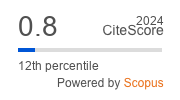Temperature studies of Hall field sensors based on nanosized silicon-on-insulator heterostructures
https://doi.org/10.17073/1609-3577-2021-4-234-241
Abstract
Microelectronics is one of the industries that have been developing at a record pace in recentdecades. The most important role in the development of the digital economy is played by the development and organization of the production of a new generation of microelectronic sensors of external influences and microsystems based on them. Due to the need to operate such devices under various conditions, including wide temperature ranges, determining the ranges of their reliable operation is an urgent task. Thermal studies are carried out using the previously constructed two-level mathematical model of a Hall field sensor (HFS) based on a silicon-on-insulator (SOI) heterostructure. The results of computational and experimental studies of the influence of temperature on the characteristics of the SOI HFS are presented. The possibility of operation of the sensor in a wide temperature range is shown. Parametric identification of the mathematical model developed by the authors based on the experimental data is carried out. The sensitivity function of the electric current to temperature change is determined. The proposed approach makes it possible to estimate the required sensitivity of the sensor to determine the temperature with the given accuracy.
About the Authors
K. K. AbgaryanRussian Federation
44-2 Vavilova Str., Moscow 119333
Karine K. Abgaryan — Dr. Sci. (Phys.-Math.), Chief Researcher, Head of Department
A. V. Leonov
Russian Federation
6 Academician Ossipyan Str., Chernogolovka, Moscow Region, 142432
Alexey V. Leonov — Cand. Sci. (Phys.-Math.), Researcher
D. L. Reviznikov
Russian Federation
44-2 Vavilova Str., Moscow 119333
Dmitry L. Reviznikov — Dr. Sci. (Phys.-Math.), Professor
References
1. Abgaryan K.K., Reviznikov D.L. Computational algorithms in problems of simulation and optimization of semiconductor heterostructures. Moscow: MAKS Press; 2016, 120 p. (In Russ.)
2. Abgaryan K.K., Reviznikov D.L. Numerical simulation of the distribution of charge carrier in nanosized semiconductor heterostructures with account for polarization effects. Computational Mathematics and Mathematical Physics. 2015; 56(1): 153—164. (In Russ.). https://doi.org/10.7868/S004446691601004X
3. Abgaryan K.K., Mutigullin I.V., Reviznikov D.L. Computational model of 2DEG mobility in the AlGaN/GaN heterostructures. Physica Status Solidi (c). 2015; 12(4-5): 460—465. https://doi.org/10.1002/PSSC.201400200
4. Abgaryan K.K., Mutigullin I.V., Reviznikov D.L. Theoretical investigation of 2DEG concentration and mobility in the AlGaN/GaN heterostructures with various Al concentrations. Physica Status Solidi (c). 2015; 12(12): 1376—1382. https://doi.org/10.1002/PSSC.201510159
5. Mordkovich V.N., Abgaryan K.K., Reviznikov D.L., Leonov A.V. Simulation of hall field elements based on nanosized silicon-on-insulator heterostructures. Russian Microelectronics. 2021; 50(8): 617—622. https://doi.org/10.1134/S1063739721080059
6. Mordkovich V.N. Sensors based on “silicon on insulator” structures. Elektronnaya Tekhnika. Seriya 2: Poluprovodnikovye Pribory. 2008; 2(221): 34—44. (In Russ.)
7. Meiyer G.C.M., ed. Huijsing I.H. Smart Sensor Systems: Why? Where? How? Great Britain: I. Wiley and Sonus; 2008. 385 p. https://doi.org/10.1002/9780470866931.CH1
8. Balakrishnan V., Phan H.-P., Dinh T., Dao D.V., Nguyen N.-T. Sensors for harsh environments. Sensors. 2017; 17(9): 2060—2092. https://doi.org/10.3390/s17092061
9. Baumgartner A., Ihn T., Ensslin K., Papp G., Peeters F., Maranowski K., Gossard A.C. Classical Hall effect in scanning gate experiments. Physical Review B. 2006. 74: 165426. https://doi.org/10.1103/PhysRevB.74.165426
10. Shcherbachev K.D., Bublik V.T., Mordkovich V.N., Pazhin D.M. Specific features of formation of radiation defects in the silicon layer in “silicon-on-insulator” structures. Semiconductors. 2011; 45(6): 754—758. (In Russ.)
11. Mordkovich V.N., Pazhin D.M., Gromov D.V., Skorobogatov P.C. Relaxation effects in field hall sensor influence of impulse ionizing irradiation. Elektronnaya Tekhnika. Seriya 2: Poluprovodnikovye Pribory. 2011; 1(226): 19—26. (In Russ.)
12. Korolev M.A., Kozlov A.V., Petrunina S.S. Functioning features of the SOI field-effect hall sensor designed for application in telecommunications networks. Trudy MFTI. 2015; 7(3): 91—95. (In Russ.)
13. Korolev M.A., Pavlyuk M.I., Devlikanova S.S. Physical model of SOI field-effect hall sensor. Proceedings of Universities. Electronics. 2017; 22(2): 166—170. https://doi.org/10.24151/1561-5405-2017-22-2-166-170
14. Popovich R.S. Hall effect devices. 2nd. ed. Bristol; Philadelphia: Institute of Physics; 2004. 419 p.
15. Leonov A.V., Malykh A.A., Mordkovich V.N., Pavlyuk M.I. Thin-film silicon magnetically sensitive field-effect transistor of the Hall type with an extended operating temperature range up to 350 °С. Technical Physics Letters. 2016; 42(2): 30—36. (In Russ.)
16. Leonov A.V., Malykh A.A., Mordkovich V.N., Pavlyuk M.I. Field controlled Si hall element with extended operation temperature range from liquid helium temperature up to 650 K. Procedia Engineering. 2015; 120: 1197—1200. https://doi.org/10.1016/J.PROENG.2015.08.786
17. Stengel F., Noor Mohammad S., Morkoc H. Theoretical investigation of electrical characteristics of AlGaN/GaN modulation doped field-effect transistors. Journal of Applied Physics. 1996; 80(5): 3031—3042. https://doi.org/10.1063/1.363162
18. Naumova O.V., Zaitseva E.G., Fomin B.I., Ilnitsky M.A., Popov V.P. Density dependence of electron mobility in the accumulation mode for fully depleted soi films. Semiconductors. 2015; 49(10): 1360—1365. (In Russ.)
Review
For citations:
Abgaryan K.K., Leonov A.V., Reviznikov D.L. Temperature studies of Hall field sensors based on nanosized silicon-on-insulator heterostructures. Izvestiya Vysshikh Uchebnykh Zavedenii. Materialy Elektronnoi Tekhniki = Materials of Electronics Engineering. 2021;24(4):234-241. (In Russ.) https://doi.org/10.17073/1609-3577-2021-4-234-241






































